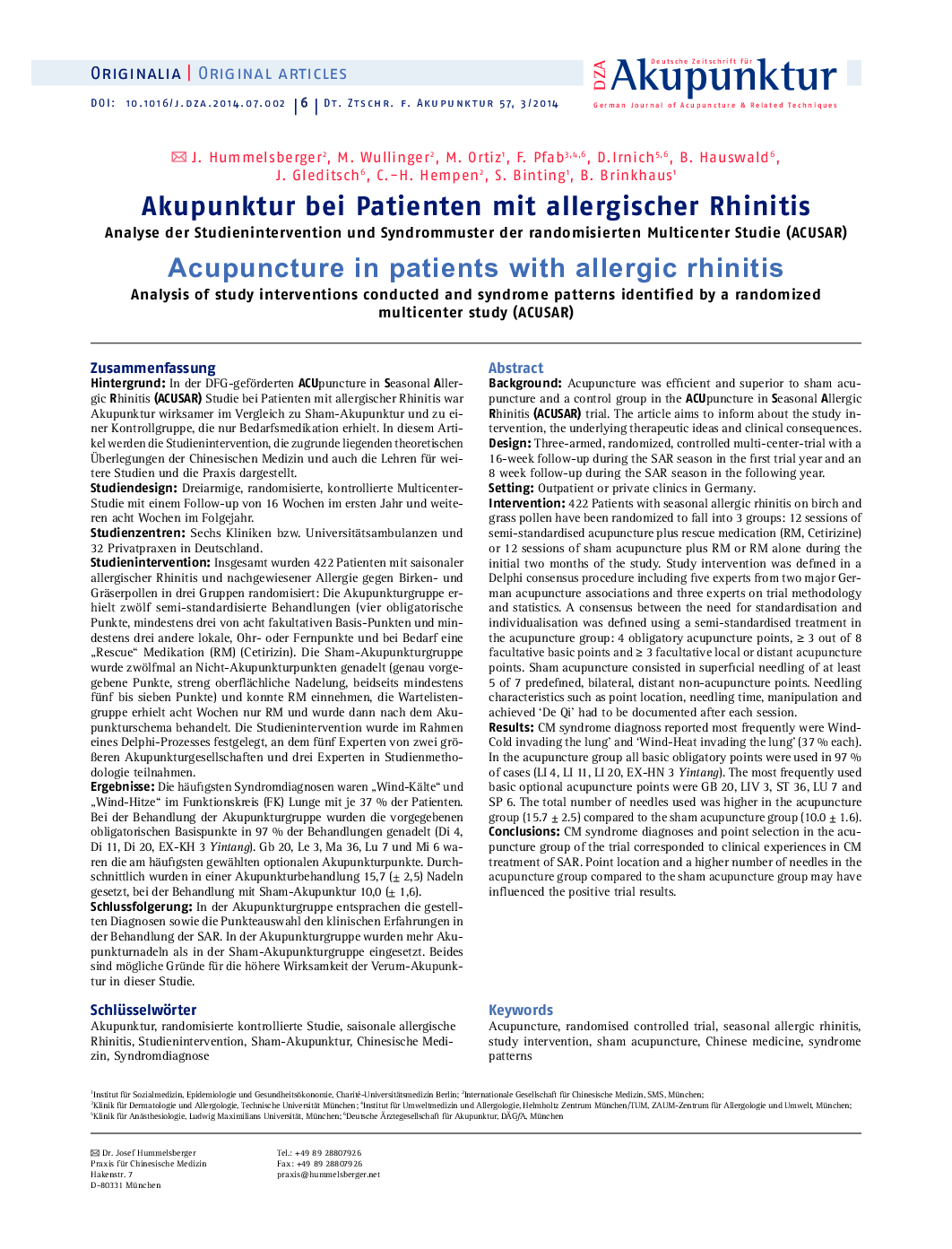| کد مقاله | کد نشریه | سال انتشار | مقاله انگلیسی | نسخه تمام متن |
|---|---|---|---|---|
| 2615978 | 1135142 | 2014 | 6 صفحه PDF | دانلود رایگان |

ZusammenfassungHintergrundIn der DFG-geförderten ACUpuncture in Seasonal Allergic Rhinitis (ACUSAR) Studie bei Patienten mit allergischer Rhinitis war Akupunktur wirksamer im Vergleich zu Sham-Akupunktur und zu einer Kontrollgruppe, die nur Bedarfsmedikation erhielt. In diesem Artikel werden die Studienintervention, die zugrunde liegenden theoretischen Überlegungen der Chinesischen Medizin und auch die Lehren für weitere Studien und die Praxis dargestellt.StudiendesignDreiarmige, randomisierte, kontrollierte Multicenter-Studie mit einem Follow-up von 16 Wochen im ersten Jahr und weiteren acht Wochen im Folgejahr.StudienzentrenSechs Kliniken bzw. Universitätsambulanzen und 32 Privatpraxen in Deutschland.StudieninterventionInsgesamt wurden 422 Patienten mit saisonaler allergischer Rhinitis und nachgewiesener Allergie gegen Birken- und Gräserpollen in drei Gruppen randomisiert: Die Akupunkturgruppe erhielt zwölf semi-standardisierte Behandlungen (vier obligatorische Punkte, mindestens drei von acht fakultativen Basis-Punkten und mindestens drei andere lokale, Ohr- oder Fernpunkte und bei Bedarf eine „Rescue“ Medikation (RM) (Cetirizin). Die Sham-Akupunkturgruppe wurde zwölfmal an Nicht-Akupunkturpunkten genadelt (genau vorgegebene Punkte, streng oberflächliche Nadelung, beidseits mindestens fünf bis sieben Punkte) und konnte RM einnehmen, die Wartelistengruppe erhielt acht Wochen nur RM und wurde dann nach dem Akupunkturschema behandelt. Die Studienintervention wurde im Rahmen eines Delphi-Prozesses festgelegt, an dem fünf Experten von zwei größeren Akupunkturgesellschaften und drei Experten in Studienmethodologie teilnahmen.ErgebnisseDie häufigsten Syndromdiagnosen waren „Wind-Kälte“ und „Wind-Hitze“ im Funktionskreis (FK) Lunge mit je 37 % der Patienten. Bei der Behandlung der Akupunkturgruppe wurden die vorgegebenen obligatorischen Basispunkte in 97 % der Behandlungen genadelt (Di 4, Di 11, Di 20, EX-KH 3 Yintang). Gb 20, Le 3, Ma 36, Lu 7 und Mi 6 waren die am häufigsten gewählten optionalen Akupunkturpunkte. Durchschnittlich wurden in einer Akupunkturbehandlung 15,7 (± 2,5) Nadeln gesetzt, bei der Behandlung mit Sham-Akupunktur 10,0 (± 1,6).SchlussfolgerungIn der Akupunkturgruppe entsprachen die gestellten Diagnosen sowie die Punkteauswahl den klinischen Erfahrungen in der Behandlung der SAR. In der Akupunkturgruppe wurden mehr Akupunkturnadeln als in der Sham-Akupunkturgruppe eingesetzt. Beides sind mögliche Gründe für die höhere Wirksamkeit der Verum-Akupunktur in dieser Studie.
BackgroundAcupuncture was efficient and superior to sham acupuncture and a control group in the ACUpuncture in Seasonal Allergic Rhinitis (ACUSAR) trial. The article aims to inform about the study intervention, the underlying therapeutic ideas and clinical consequences.DesignThree-armed, randomized, controlled multi-center-trial with a 16-week follow-up during the SAR season in the first trial year and an 8 week follow-up during the SAR season in the following year.SettingOutpatient or private clinics in Germany.Intervention422 Patients with seasonal allergic rhinitis on birch and grass pollen have been randomized to fall into 3 groups: 12 sessions of semi-standardised acupuncture plus rescue medication (RM, Cetirizine) or 12 sessions of sham acupuncture plus RM or RM alone during the initial two months of the study. Study intervention was defined in a Delphi consensus procedure including five experts from two major German acupuncture associations and three experts on trial methodology and statistics. A consensus between the need for standardisation and individualisation was defined using a semi-standardised treatment in the acupuncture group: 4 obligatory acupuncture points, ≥ 3 out of 8 facultative basic points and ≥ 3 facultative local or distant acupuncture points. Sham acupuncture consisted in superficial needling of at least 5 of 7 predefined, bilateral, distant non-acupuncture points. Needling characteristics such as point location, needling time, manipulation and achieved ‘De Qi' had to be documented after each session.ResultsCM syndrome diagnoss reported most frequently were Wind-Cold invading the lung' and ‘Wind-Heat invading the lung' (37 % each). In the acupuncture group all basic obligatory points were used in 97 % of cases (LI 4, LI 11, LI 20, EX-HN 3 Yintang). The most frequently used basic optional acupuncture points were GB 20, LIV 3, ST 36, LU 7 and SP 6. The total number of needles used was higher in the acupuncture group (15.7 ± 2.5) compared to the sham acupuncture group (10.0 ± 1.6).ConclusionsCM syndrome diagnoses and point selection in the acupuncture group of the trial corresponded to clinical experiences in CM treatment of SAR. Point location and a higher number of needles in the acupuncture group compared to the sham acupuncture group may have influenced the positive trial results.
Journal: Deutsche Zeitschrift für Akupunktur - Volume 57, Issue 3, 2014, Pages 6–11